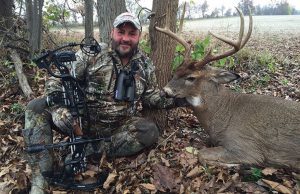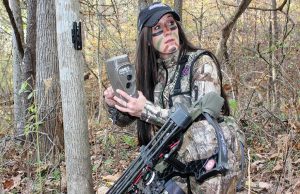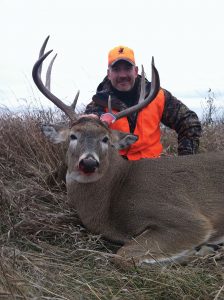My first few grunts yielded no responses, so after a brief interlude I increased the volume with the next few. Only moments had gone by when cornstalks began rustling. With shooting light fading, I identified the approaching buck as a solid public land candidate and attached my release to my D-loop.
The hair-raised buck walked stiff-legged toward a scrape 30 yards away from my treestand. I reached full draw. My trail camera captured him as he arrived, and my arrow punched through both of his lungs as he stood over the scrape. He ran 60 yards and collapsed. The hunt unfolded late in September several seasons ago, and it taught me that scrape hunting can be dynamite.
I’ve hunted areas littered with fresh scrapes countless times, and my encounters with mature bucks have been few because I mostly hunt on public land or pressured private ground where scraping activity unfolds primarily after legal shooting hours. More often I face boredom and the curiosity of what’s moving near my other stands.
I’m not trying to discourage you from hunting scrapes. As my anecdotal reference above proves, scrape hunting can take you from 0 to 60 in seconds, and to experience that rush you must hunt scrapes regularly. But before you become a scrape patroller, let’s review insights from several noted whitetail experts.
Ralph and Vicki Cianciarulo – The Choice and Archer’s Choice TV Hosts
“My wife Vicki and I find the most active scrapes along thoroughfares with good cover leading between bedding and feeding areas. Field scrapes are good, but they mainly see nocturnal movement.
“During the pre-rut, you’ll see many little scrapes open up, then you’ll see more consistent buck movement. We love this time of year, but once breeding begins scraping activity subsides. However, an area like the one I mentioned above still puts you in a great transition area to intercept a buck.
“Using some doe pee in a scrape hurts nothing. I believe scent helps many hunters get the shot of their dreams. But don’t hunt a poor wind direction. Wind is everything during the timeframe when scrape hunting is most productive. Of course, movement is more frenzied during the rut, allowing you some leeway with the wind once seeking and chasing begins.
“We create mock scrapes at strategic locations to help improve situations. We’ve seen them work quite well. Just last fall, in fact, we put in a mock scrape and had some risks with the prevailing winds. We knew not to hunt it until the wind was right, and the first evening we hunted it we shot a nice buck and coyote from the setup. The beauty of mock scrapes is that they can be placed to give you more control over the location as far as your setup in relation to prevailing wind directions.”
For more information on Ralph and Vicki Cianciarulo, visit www.archerschoicemedia.com.
Melissa Bachman – Winchester Deadly Passion TV Hostess
“Generally, I find the most active scrapes on field edges or along mowed trails. I’ve also noticed most scrapes pop up in the same locations where they were the previous year.
“I’m a big fan of scrape hunting, but I like to put a Cuddeback on them first. This tells me when bucks are coming, the direction from which they’re approaching and when the scrapes are most active.
“Most scraping activity occurs at night, so my favorite time to hunt a scrape is the moment I start getting daylight photos of bucks working it. You can actually get ahead of the game by placing cameras where you’ve seen scrapes in the past. As soon as the scrapes open back up, get in there to hunt immediately.
“I like to add a little scent to an existing scrape just to pique a mature buck’s curiosity. This causes him to think another buck was in the area using the scrape, and may cause him to check it more frequently.
“I generally create mock scrapes near a natural scrape or scrape line close to my stand. I believe this is an excellent way to get nocturnal bucks to visit during daylight. I make a big visual scrape then hang a Wildlife Research Center Magnum Scrape Dripper filled with WRC’s Active Scrape or Golden Scrape above it. WRC’s Magnum Scrape Dripper has an interior balloon that only releases scent during daylight hours, causing mature bucks to visit more often. I also like to create a scent trail from the scrape to a main trail. This often grabs the attention of passing bucks and leads them right to my mock scrape and shooting lane.
“When I hunt scrapes, I typically put out a decoy, too. I like to exploit their desire and instincts to fight. I’ve had incredible success with this in Iowa and South Dakota. When bucks stroll through to check scrapes they can smell the new scent I’ve dispersed, plus they can see my decoy. Mix in a little grunting or rattling and they’ll rarely ignore the ‘intruder.’ Having all these elements in place can trick numerous senses, and bucks often approach stiff-legged and ready to fight. I’ve had this happen once in Iowa and twice in South Dakota. It was not only super-successful, but a really fun and exciting way to hunt.”
For more information on Bachman's show, visit www.thesportsmanchannel.com.
Lee and Tiffany Lakosky – The Crush TV Hosts
Lee: “During the pre-rut, mature bucks more actively visit scrapes. During peak rut, smaller bucks may hit scrapes, but mature bucks are chasing and tending does. Once I see the bucks on their feet chasing, I usually leave the pre-rut scrapes and head to the largest concentration of does, which is usually at a food source. Once the mature bucks start chasing, they aren’t too concerned with scraping, at least not like they were during the pre-rut.”
Tiffany: “Lee typically calls the shots on where he thinks we should hunt, but I really enjoy sitting over the licking branches he creates in our fields. He buries a fencepost about 30 yards away from our treestands in the middle of the field. The fencepost has a hole in the top so we can attach a licking branch. Every deer that walks by it seems to come in and check it out, even ones that aren’t real inquisitive.”
Lee: “The biggest thing I’ve learned about scrapes and trail cameras is that you need to back off a little. Get to know your camera and how wide or narrow the lens is so you capture the entire deer in the picture every time. Field-edge scrapes always seem to be the best for me to get the most action and take inventory of which bucks are using the area. I don’t like to go into the woods very often to check cameras, but on the flipside of that I’m in the fields almost daily whether I’m farming, checking cameras, hanging stands, mowing lanes, etc. It’s all about even pressure. Avoid busting into areas where they’re not accustomed to smelling you.”
Tiffany: “We put little time into pre-rut morning hunts. If deer aren’t moving a lot, you often mess things up for the afternoon hunts anyway. We normally just wait until the big bucks are on their feet before we start hunting the mornings hard. Then it’s sometimes worth sitting all day.
“We’ve had lots of success using Wildlife Research Center’s Magnum Scrape Dripper and Golden Estrus on our rubbing posts and licking branches. We hang them on the licking branches just out of reach, and it seems to keep the scrape active over a longer time period. Plus, it cuts the visits and intrusion required to manually apply scent in the scrape."
For more information on The Crush, visit www.thecrush.tv.
Kip Adams – QDMA Director of Education & Outreach and Certified Wildlife Biologist
“Scrapes serve as signposts or bulletin boards for whitetails. They’re a place to exchange information with other deer in the area. Deer can leave information via their saliva, forehead and preorbital glands on the licking branch above the scrape, and via their urine and interdigital gland in the scrape. Given a whitetail’s highly complex olfactory system, scrape use and behavior is a perfect way to communicate. Thus, it only makes sense that bucks, does and fawns regularly use them.
“Certain features increase the odds of finding scrapes — some are along field edges, woods roads and areas with high deer traffic. Remember that scrapes are like bulletin boards, so bucks intentionally make them in high-traffic areas. They don’t necessarily use the exact same scrapes annually, but they often use the same general areas and routes. They also don’t necessarily have ‘scrape lines.’ Research shows numerous bucks (and does) can use the same scrape, and in some cases, a line of scrapes was used by entirely different bucks.
“It is common knowledge that bucks use scrapes to advertise their presence and gain information on other deer in the area before and during the breeding season. Many hunters even
know that most scrape visitations occur at night — about 84 percent. Thus, hunting right over scrapes is generally unproductive. A better strategy involves hunting a travel route between a bedding area and an area with active scrapes. There, you can intercept a buck as he heads to a scrape before shooting hours’ end or catch him as he returns to his bedding area in the morning.
“Again, most scrape visits occur at night. However, some do occur during shooting hours, and I personally believe that more daytime visits occur following a hard rain that may have washed away the scent (advertisement) deer left before the storm.
“Great research from Penn State showed that human urine and even ‘new car smell’ used in a scrape attracted as many bucks as scrapes laced with doe urine and doe-in-heat urine. Scrapes are a visual attractant (the exposed dirt), and they also have olfactory attractants (urine, saliva and possibly glandular material from the preorbital or forehead glands). You can create a mock scrape without using any scents, and it can be very effective. You can also add attraction by using a deer scent.
“Mock scrapes effectively create locations at which to photograph deer. For the reasons stated above, scrapes — created by deer or hunters — aren’t necessarily great hunting locations. Still, they can be very helpful at patterning deer when you monitor them with trail cameras."
For more information on the QDMA, visit www.qdma.com.









